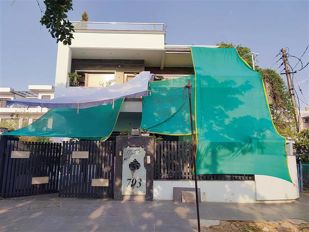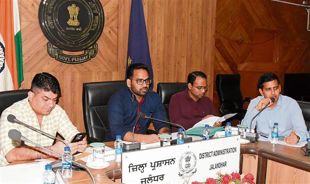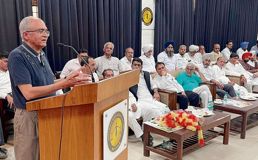
A view of Pucca Tank, Nahan.
Shriniwas Joshi
Not far back, we in Himachal behaved like a water-rich country, take our daily showers, water the lawn or garden, never used water sparingly. Not now. Shimla recently remained parched for seven days. The High Court has directed the government to punish the officials who kept Shimla thirsty for a week. It is the High Court that appears to run the state. The judiciary did excellent work in nominating persons in various zones of Shimla to be contacted when in dire need of water. Their telephone numbers were broadcast from Prasar Bharati every day till the difficult days persisted. Every government should understand that water has the same popular appeal as justice, freedom and equality, representation and power. I wonder why the Executive could not think that Chadwick Fall is, now, a Fall in name only. One has to carry two canisters of water to the top of the Fall and pour out the water to see how it worked in the olden days. It is, again, the High Court which has come forward to form a committee to find out ways and means to bring Chadwick to its old glory. Deepak Sanan, former additional chief secretary, had come back from Cape Town recently and he told me that the government and people have, in unison, walked over the water crisis there. The warning begins even before a tourist arrives there. “Cape Town is suffering through an extreme water crisis,” the pilot explains on approach, imploring tourists and travellers to save water. Sanan told me that the residents there responded magnificently, rolled up their sleeves and got stuck to the instructions given by the government. It is for certain that the situation in Shimla is almost a foretaste of what is likely to come in other cities of Himachal too.
Pamela Kanwar writes in ‘Imperial Simla’ that Simla was dependent for her water supply upon over 17 natural springs and ‘baolis’. Where have all these gone? These are carelessly lost without care. The Environment Society of Nahan, which was registered as Society on the September 17, 1990, at Nahan has shown us the way how to conserve the water bodies. Though they cover all aspects of environmental degradation of the town; deteriorating standards of cleanliness, the menace of deforestation, the neglect of most cheery forest walks in the town, called Shamsher Villa Round, the dying culture of the maintenance of the parks, yet their emphasis had been on conserving the heritage tanks and ‘baolis’ around the town.
Cleaning of Kalisthan Tank was their first project. Dr. Suresh Joshi has been a motivating force in the Society. Kalisthan, more than a 150-year-old tank, had become the garbage bin of the town. Hyacinth weed and the waste material of Nahan was all that was there. Community service every morning, the help of military present at Nahan, students of the schools and the then Deputy Commissioner, Rakesh Kaushal, and his team could make it possible to clean the tank of rubbish and trash after putting in an effort for two years. I, in my recent visit, found it dirty again. Somebody had thrown a Kamal (Lotus) weed in it which has grown like Topsy. It has to be removed first. The Environment Society has demanded a boat for keeping it clean. The biggest tank at Nahan is more than 250- year-old Pucca Tank. The Nagar Parishad had desired to construct a market here. The Environment Society and the Nagrik Sabha were against any such construction. The matter went to the High Court where the Court decided in favour of the Environment Society. The tank was cleaned to fill it with fresh water. Today, it is filled with greenish looking rain water.
There are about twenty baolis around Nahan. These baolis were cleaned by the Environment Society with the help of school students and 14 of these have been adopted by the schools for periodic cleaning – four by EVN School, three by Carmel Convent, three by SVN School, two by ESN and two by DAV School. The ladies from the nearby villages came out and started thanking and blessing those who had done the conservation of this water body when I happened to visit one of the ‘baolis’. They said their families and the animals were getting clean and fresh water now, which had disappeared a few years back. They have recently located a big ‘baoli’ ‘Shivpuri’ at Nahan. Its rejuvenation will be taken up by the Society when the schools open.
The national rural drinking water programme, envisaged in the year 2010, says, “Water is a public good (utility) and every person has the right to demand drinking water and it is the lifeline activity of the government to ensure that the basic need of the people is met.” Words will not suffice; somebody has to work like The Environment Society, Nahan.
Tailpiece
“Water - a priceless treasure; save it with pleasure.” Food, water and compliments are what we all need .



























